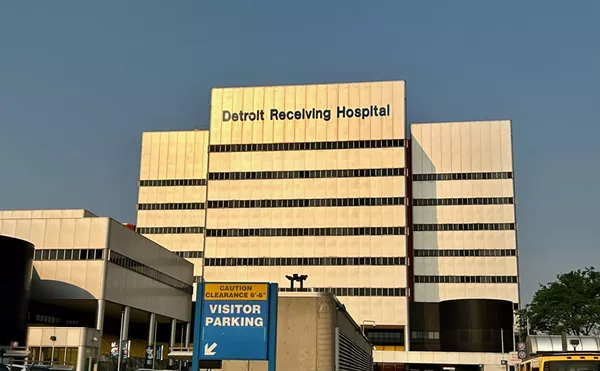
Audio By Carbonatix
[
{
"name": "GPT - Leaderboard - Inline - Content",
"component": "35519556",
"insertPoint": "5th",
"startingPoint": "3",
"requiredCountToDisplay": "3",
"maxInsertions": 100,
"adList": [
{
"adPreset": "LeaderboardInline"
}
]
}
]
"It’s one after the other," says Lewis.
But if plans go through to expand a nearby truck- and train-shipping yard from 580 acres to 850 acres (with another 450 acres for buffer zones), the traffic, noise — and pollution — will almost certainly increase in this low-income neighborhood, where the 65-year old Lewis has lived all her life.
Since last spring, the Michigan Department of Transportation has been studying the neighborhood to determine whether public money should be used to expand the yard and build four freight terminals where trains and trucks would meet to exchange cargo. MDOT says that the railroad companies need new terminals and are looking to the transportation department for money to build them. But the railroad companies don’t seem that enthused about the project, which is estimated to cost hundreds of millions of dollars. Though the state agency has not decided whether to subsidize the project, it is pushing hard to promote it. MDOT says that having major freight terminals in one area will reduce southeast Michigan’s traffic. Trucks would be rerouted to upgraded roads in southwest Detroit, preventing damage to streets not built for them; trains will take over long hauls from trucks, which would decrease traffic, according to MDOT.
Southwest Detroit will see an increase of 16,000 truck trips a day by 2025 if the four terminals are built; an increase from 2,000 trips today.
But the big draw, say transportation department officials and project supporters such as the cities of Detroit and Dearborn, is that the central shipping district will attract businesses to Michigan and create jobs.
Others, including Lewis, who may be forced to move if the yard is expanded, are skeptical. They fear that southwest Detroit — which by MDOT’s estimates may lose up to 81 homes and 99 businesses with the new development — will become a dumping ground for southeast Michigan’s truck traffic.
Neighborhood threat
Since the mid-1990s, MDOT, businesses and local governments have considered building a central shipping yard or "intermodal freight terminal" in southeast Michigan where trucks and trains would work together to ship goods in the region and outstate. For the most part, trucks and trains compete for delivery business. But many intermodal terminals are cropping up around the country and state as the need to move goods increases with international trade and other economic factors.
Currently, there are nine small terminals scattered in southeast Michigan. But most of the terminals are either already operating at capacity or nearing it, and the railroads say they need more facilities to meet shipping demands, according to MDOT.
In 1997, MDOT received $18 million in federal funds to study the issue. MDOT initially considered where the terminal should go and settled on southwest Detroit, specifically the area that surrounds and includes the Livernois-Junction Yards and borders east Dearborn. The rail lines, access to major highways and the mostly industrially zoned property make it an ideal location, says Ari Adler, MDOT communications director.
In March, the transportation department began taking a closer look at the area and met with residents and business owners to get their input. Many folks aren’t pleased.
At a nearly three-hour meeting last spring, residents and community leaders pelted MDOT with questions and criticisms. A couple business owners said they welcomed the development hoping that it would generate jobs in the area, but most of the 45 or so people who attended expressed concerns. Some said they fear that more rail lines would fragment the neighborhood. Others complained that southwest Detroit is already inundated with industry pollution and noise. But Greg Bowens, spokesman for Mayor Dennis Archer, says that residents are often critical of new development in Detroit.
"It is a byproduct of growth," says Bowens. But he adds that the new terminal is necessary.
It will increase the number of trucks in the area, which will generate fuel taxes and fees collected on weight limits, he says. "Having that kind of station there also allows us to attract more businesses because we can demonstrate that Detroit is the hub of shipping activity."
Some are not so sure. Businesses, churches, and other neighborhood groups formed Communities for a Better Rail Alternative. They are dissatisfied with MDOT’s proposal to more than double the size of the Livernois-Junction Yards, possibly clear out about 180 homes and businesses and increase truck traffic by about 16,000 truck trips a day.
"If they expand to 1,300 acres, you may as well kiss many of these neighborhoods goodbye," says Karen Kavanaugh, who helped organize the coalition and is the Southwest Detroit Business Association planning director. Kavanaugh says that the group wants a plan that not only improves the transportation of freight but people, while preserving the only Detroit neighborhood where the population is growing. According to the U.S. Census count the population in southwest Detroit increased from? in 1990 to ? today. Dozens of restaurants, grocery stores, bakeries and other businesses also have opened in southwest Detroit.
"They want to do this by tearing down the only growing neighborhood in Detroit," says Kavanaugh.
Who’s driving this train?
If MDOT drops the project, Adler says that the railroad companies, which need more freight terminals, will pick up the tab and carry on alone.
"It’s going to happen from the railroad companies’ standpoint. What is not known at this point, is it something the government will invest in?" he says.
Adler also points out that if the transportation department is not involved it could be bad news for the neighborhoods. The government agency is legally mandated to seek public input; the railroads can act unilaterally.
However, in interviews with the Metro Times, the railroads don’t seem to be the driving force behind the proposed expansion. "The state has been looking at it off and on for some time and we’re interested enough to keep plugged in," says Randy Marsh, Canadian Pacific Rail communications specialist. "The market potential is great."
Norfolk Southern says that it hopes to expand, but not anytime soon.
CSX Transportation says it also does not plan to expand. "We really can’t afford to do it," says Bob Sullivan, CSX Transportation spokesperson. "If there is going to be growth, it’s going to be somewhat more modest than what is envisioned there."
Canadian National did not return Metro Times’ phone calls.
But MDOT insists that the rail and truck companies would increase business if the facility went up. Adler says that companies outside Michigan say they will move here if a central shipping terminal is built. Asked which companies said this, Adler could only name the big three automakers. However, they seemed only vaguely enthusiastic when talking to Metro Times.
"It’s more of a wait-and-see," says David Barnas, General Motors media relations manager, about whether the company will be able to use the facility for its business.
"Anything that supports moving goods in an efficient manner, we support. But this terminal we would use very little," because we already have efficient transport systems, says Mike Parris, Ford Motor Company public affairs manager.
For DaimlerChrysler to use the facility it would need to be cost-effective and have a state-of-the-art delivery tracking system that complements DCX’s own, says an auto company spokesperson.
So why is MDOT gung ho about the freight terminal when those who would might use it are only mildly interested?
Michael Belzer, Wayne State associate professor in the Center for Urban, Labor and Metropolitan Affairs department, suspects that funding is driving the project. He says that with the increase in truck traffic around the country, millions of federal dollars are available to build intermodal terminals to reduce truck traffic. MDOT may be trying to get its share for Michigan. And by rerouting most truck traffic to one area like southwest Detroit, the state will spend less money repairing roads.
"It might, on some level, be better for the state, but not Detroit," says Belzer. Ann Mullen is a Metro Times’ staff writer. She can be reached at





